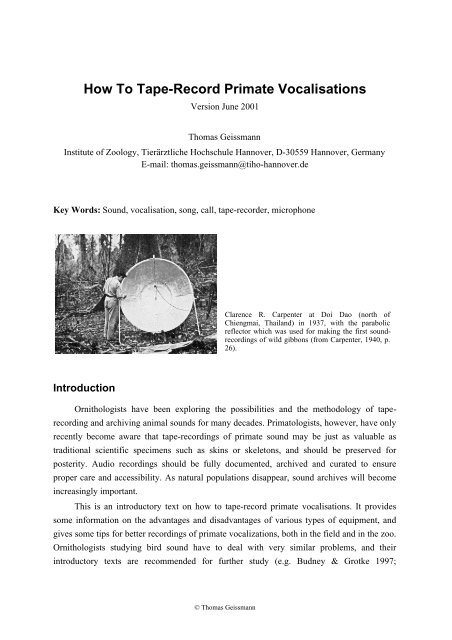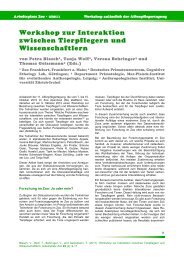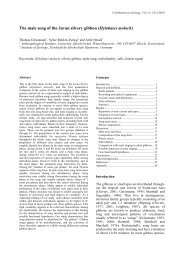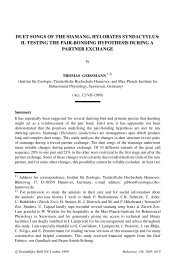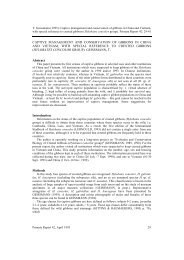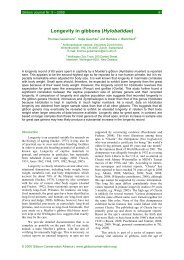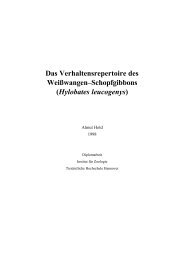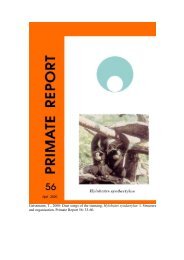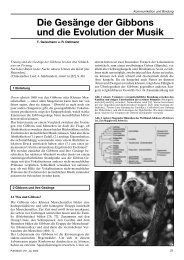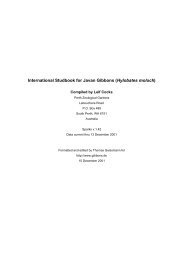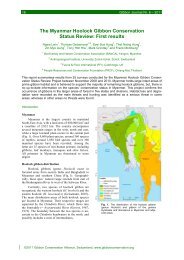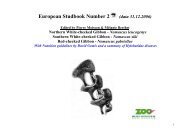How To Tape-Record Primate Vocalisations - Gibbon Research Lab
How To Tape-Record Primate Vocalisations - Gibbon Research Lab
How To Tape-Record Primate Vocalisations - Gibbon Research Lab
- No tags were found...
Create successful ePaper yourself
Turn your PDF publications into a flip-book with our unique Google optimized e-Paper software.
<strong>How</strong> <strong>To</strong> <strong>Tape</strong>-<strong>Record</strong> <strong>Primate</strong> <strong>Vocalisations</strong>Version June 2001Thomas GeissmannInstitute of Zoology, Tierärztliche Hochschule Hannover, D-30559 Hannover, GermanyE-mail: thomas.geissmann@tiho-hannover.deKey Words: Sound, vocalisation, song, call, tape-recorder, microphoneClarence R. Carpenter at Doi Dao (north ofChiengmai, Thailand) in 1937, with the parabolicreflector which was used for making the first soundrecordingsof wild gibbons (from Carpenter, 1940, p.26).IntroductionOrnithologists have been exploring the possibilities and the methodology of taperecordingand archiving animal sounds for many decades. Primatologists, however, have onlyrecently become aware that tape-recordings of primate sound may be just as valuable astraditional scientific specimens such as skins or skeletons, and should be preserved forposterity. Audio recordings should be fully documented, archived and curated to ensureproper care and accessibility. As natural populations disappear, sound archives will becomeincreasingly important.This is an introductory text on how to tape-record primate vocalisations. It providessome information on the advantages and disadvantages of various types of equipment, andgives some tips for better recordings of primate vocalizations, both in the field and in the zoo.Ornithologists studying bird sound have to deal with very similar problems, and theirintroductory texts are recommended for further study (e.g. Budney & Grotke 1997;© Thomas Geissmann
Geissmann: <strong>How</strong> to <strong>Tape</strong>-<strong>Record</strong> <strong>Primate</strong> <strong>Vocalisations</strong> 2Kroodsman et al. 1996). For further information see also the websites listed at the end of thisarticle.As a rule, prices for sound equipment go up over the years. Prices for equipmentdiscussed below are in US$ and should only be used as very rough estimates. Prices asked byvarious sellers for the same product differ widely and comparing prices over the internetbefore buying is recommended.This article does not describe methods and equipment required for sound analysis.Information on that topic has been presented elsewhere (Charif et al. 1995; Hopp et al. 1998).Sound recordersSound recorders can be analog or digital. They record an electrical signal generated by amicrophone. An ideal recorder records a signal without alterations by at least matching itsdynamic and frequency range and by preserving all its features. Traditional analog taperecorders,both compact cassette and reel-to-reel recorders, are not perfect. They degrade thesignals they record by adding hiss, distortion, frequency response alterations, speedvariations, print-through effects, and drop-outs. Digital recorders don't have these problems.Within the dynamic range and the frequency limits (due to the number of bits and samplingfrequency they use), they record and reproduce signals with great accuracy, low noise, flatfrequency response, and no speed variations. Nevertheless, good analog tape-recorders willrecord a signals in a quality which is good enough for most purposes of bioacoustic studies.Analog tape-recorders (Audio)In earlier times, tape-recordings made with reel-to-reel tape-recorders were superior inquality to cassette recorders, and many purists are still using the former because they providethe best analog quality. It is possible, nevertheless, to produce high quality recordings withlight-weight cassette recorders. These machines weigh much less than reel tape-recorders,which is a great advantage for field studies.Avoid working with noise reduction technologies such as Dolby or DBX. While thesenoise reduction systems certainly will reduce tape hiss, they add distortion and limit the highfrequencies of many sounds. Always switch off Dolby during the recording.If possible, use a tape-recorder with adjustable sensitivity for signal intensity. Theautomatic level control (ALC) that is found on many portable cassette recorders is very handyfor dictation but is often ineffective for recording sounds in the field. Unfortunately, there arevery few portable machines with adjustable sensitivity.The Sony Walkman WM-D6 is small, relatively affordable (about $360), and workswell in rough field conditions. Bar type metering or LED (light emitting diode) is used. TheLED's are difficult to read in bright light; in addition they are positioned on the top rather thanon the side facing you as you record, making them difficult to see while recording. Unlike the
Geissmann: <strong>How</strong> to <strong>Tape</strong>-<strong>Record</strong> <strong>Primate</strong> <strong>Vocalisations</strong> 5All these technologies use sound compression algorithms discarding sound detailswhich appear to be non-audible. For instance, MiniDisc technology incorporates inputfiltering and data compression strategies deliberately designed to distort the signal in subtleways which makes the signal more difficult to analyse and impossible for accurate frequencyrelatedmeasurements. It also leads to perceptible distortion if multiple copies are made. Anysuch technology will change (i.e. degrade) the sound you are recording and make yourrecordings unsuitable for sound analysis.What to buy - where is the future?Reel-to-reel machines are almost gone. It is also obvious from changes in the productlists of the major producers of audio equipment that both analog audio cassette recorders andDAT are on their way out. Whereas the analog cassettes will be still around for years to come,the DAT technology never had to build up an equally large user base and may disappearfaster. Only few good portable machines of either technology are still being sold, mainly forspecialists, and prices for these machines will probably go up as the market dries up. Thefuture will be in the digital media. Unfortunately, currently popular or announcedtechnologies such as MiniDisc, MP3 or MP4 are not an option for bioacoustic analyses.Direct-to-harddisk recording may be the option of the future, but no easily manageable androbust solution is available for long-term use in the rain forest. For the time being, at least,this writer is sticking to analog recording using audio cassettes.Microphones and parabolic reflectorsIf possible, use a directional microphone or a parabolic reflector (also called parabola).This considerably improves sound collection in nature by either attenuating unwantedambient noise and sounds from other directions (directional microphones) or by givingemphasis to the sounds coming frontally (parabolic reflectors).Directional microphones are the most useful in bioacoustic field recordings. Thedirectionality of a microphone is usually represented by a polar diagram, i.e. a graphicrepresentation of the sensitivity of the microphone with respect to the frequency and the angleof incidence of the sound. Typically, directionality increases with increasing frequency, i.e.decreasing wavelength. There are three basic directional patterns: omnidirectional,bidirectional and unidirectional, or simply directional. The latter type is of interest here.Various names are in use for microphones with various degrees of directionality. Here, I willjust differentiate between shotgun or ultradirectional microphones and semi-directionalmicrophones.
Geissmann: <strong>How</strong> to <strong>Tape</strong>-<strong>Record</strong> <strong>Primate</strong> <strong>Vocalisations</strong> 7instance if you are tape-recording "loud-calls" of primates or if you are studying captiveanimals, where background noise frequently is less of a problem and where the microphoneusually can be positioned closer to the vocalising animals. Their degree of directionality andother quality characteristics vary strongly, however (Wölfel & Schopmann 1994). In order totape-record gibbon songs, leaf monkey loud calls and macaque vocalisations in the field, Iused the following microphones with good results: Panasonic VW-VMS1E, JVC MZ-707,and Sennheiser MKE 300 (all below $200). As an advantage, these video-microphones can bedirectly plugged into the Sony WM-D6C; no special connecting cable is necessary as for thesome of the directional microphones from Sennheiser. I recommend, however, buying acheap elongation cable (1.5 m, less than $6). The microphone should never be too close to thecassette recorder while recording, otherwise you might have the noise of the machine on yourtape-recordings.Be careful to select a microphone with a frequency range suitable for your needs. Thefrequency range of some of the cheaper video-microphones does not exceed 10 kHz, whichmakes them less suited to tape-record sounds of primates with high-pitched vocalisations (e.g.callitrichids).Parabolic reflectorsA parabola focuses incoming sound waves that are parallel to its axis onto a singlepoint, the focus, where a microphone is placed. Whereas a shotgun microphone simplyscreens off sound from directions other than the sound source, a parabolic reflector canactually amplify the sound from the target direction. In addition, it also acts as a high passfilter especially for low frequency environmental sounds.Its effectiveness is determined by the diameter of the reflector in relation to thewavelength of the sound. Its gain and directivity increase proportionally with increasing thediameter/wavelength ratio. For wavelengths larger than the diameter of the parabola, theresponse is predominantly that of the microphone itself. As the wavelengths become smallerthan the parabola's diameter, gain and directivity increase as the frequency increases.Common diameters are 45 cm, 60 cm and 90 cm with directionality starting respectively atabout 750, 550 and 375 Hz. Only the larger dishes can be recommended for primate studies:they are able to cover the frequency range of calls produced by the smaller primate species, atleast. Many larger species, however, produce calls which go well below 375 Hz. For aparabola to become effective at frequencies as low as 100 Hz, its diameter must be larger than3 metres.It is obvious that the size of a parabolic reflector makes it difficult to follow primatesthrough tropical forests with this equipment in hand, even if some plastic parabola (Telinga)can be rolled up for travelling. Parabola may be of better use in stationary recording sites orin more open forests and in open habitat.
Geissmann: <strong>How</strong> to <strong>Tape</strong>-<strong>Record</strong> <strong>Primate</strong> <strong>Vocalisations</strong> 8There are a variety of parabolas available made of metal, fibreglass or clear plastic.Microphones for use in parabolic reflectors typically cost anywhere from $300 to $1,500.Some providers such as Telinga and Saul Mineroff Electronics sell complete systems whichinclude a parabolic reflector with a microphone and shock-mount system.If you have to work on a tight budget, you may consider building a parabolic reflectoryourself. With a large bowl- or umbrella-shaped dish, you can add some directionality to anynon-directional microphone. The microphone is positioned in the focal point of the reflectorwhich, fortunately, is not very narrowly defined. In this area, the sound is concentrated andyields an increased sensitivity. Björn Merker (pers. comm.) built two parabolic reflectors outof bowl-shaped plastic flower pots, and equipped each with a cheap non-directionalmicrophone and a wire handle. This construction appeared to work well, and, as anadvantage, enabled him to make stereo-recordings. When travelling, the plastic bowls couldbe placed into each other and used to contain cables and protect the microphones or the taperecorder.When recording, the two microphones were individually directed at one or two ofthe calling animals.Other equipmentMany ornithologists recommend the use of good quality headphones which allow youto listen while recording, thereby facilitating proper aiming of the microphone as well asgiving a clear idea of the quality of the recording being made. I always found it inconvenient,however, to monitor the vocal activities of primates, often calling from several directions atthe same time, with the earphones on, especially when working in the rain forest.Another essential item for field recording is the pitch pipe. If a known pitch is recordedevery so often along the tape, it is possible at a later time to adjust the playback speed tomatch the original recording. The reason for this is that not all cassette machines operate atexactly the same speed. If your recording is to be used for analytical work, accurate time andfrequency measurements are of essence. Pitch pipes are available from most music stores andare very inexpensive.I recommend using quality audio-cassettes (e.g. TDK, Maxell). Much cheaper cassettesare available, but some of them may yield fuzzy recordings and some frequency levels maybe underrepresented. Of the available cassettes Types I, II and IV, Type II tape offers betterhigh-frequency response and a lower signal-to-noise ratio. Interesting vocalisations tend tooccur exactly when the cassette is full, and you will miss them while swapping cassettes.Therefore, I prefer cassettes that let you record for 90 or 100 minutes (instead of those for 60minutes), because you need to swap cassettes less often with these. Shorter tapes, on the otherhand, exhibit a better time accuracy, because they are thicker.Always carry a set of new, unrechargeable batteries with you, for emergencies.Rechargeable batteries need to be recharged frequently. Your animals often decide to vocalise
Geissmann: <strong>How</strong> to <strong>Tape</strong>-<strong>Record</strong> <strong>Primate</strong> <strong>Vocalisations</strong> 9after you have spent hours tape-recording background noise, thus expiring all yourrechargeable batteries. In such cases, an emergency set of batteries will come handy.UltrasoundA number of small primates (e.g. Cebuella, Galago, Microcebus, Nycticebus) have beenshown to emit ultrasound vocalisations above 20 kHz (Cherry et al. 1987; Glatston 1979;Pariente 1974; Pola & Snowdon 1975; Zietemann 2000; Zimmermann 1981). Fundamentalfrequencies of some note types of Microcebus murinus were reaching maximum values ofabout 45 kHz (Zietemann 2000). Because detecting, recording and analysing ultrasoundvocalisations requires special equipment, such calls may be more widespread among smallprimates (and other small mammals) than has been documented, so far. Fortunately, muchresearch is being carried out on ultrasound calls of bats, and scientists wishing to studyultrasound vocalisations of primates can greatly benefit from exploring the expertise of, andthe technologies being used by, bat researchers.Bat detectorsBat detectors or ultrasound detectors were developed to provide researchers withinstruments to study bat echolocation, but are also used for research on other small mammalsand grasshoppers. Bat detectors are based on both analog and digital techniques to detect andrecord ultrasounds and transform them into audible sounds. The detectors available on themarket use three main systems: heterodyne frequency shifting, frequency division and timeexpansion. The most advanced instruments make use of all these three systems to makeultrasounds audible and recordable, with some limitations, on usual audio recorders.Heterodyne detectors and frequency division (or count-down) detectors are real timemethods (i.e. you hear the sound from the detector at the same time as it is emitted by thebat). They are useful for quick yes/no statements of bat activity. They allow recording anaudible representation of an ultrasonic call, not of the full ultrasonic signal structure.If you want to study the frequency spectrograms, you have to use a time expansiondetector (Petterson D980: $3,500; Ultra Sound Advice: U30 + PUSP: $2,867). The timeexpansion detector is the most accurate system: it retains all information of the originalsignal. The method is similar to making a high speed tape recording of the sound and thenplaying it back at a lower speed. But instead of using a huge traditional high speed taperecorder,the ultrasonic signal is sampled at high speed, then replayed at a lower sample rate,e.g. one tenth, to be made audible and stored in this format on a tape-recorder. If the signal isstored at a sample rate ten times lower than the original one, frequencies are reduced by tenwhile time is expanded by the same factor.Clearly this is not a real time conversion method, but it does offer a number of benefitsover and above these methods. Since the signal is stretched out in time, it is possible to hear
Geissmann: <strong>How</strong> to <strong>Tape</strong>-<strong>Record</strong> <strong>Primate</strong> <strong>Vocalisations</strong> 12In addition, try to be consistent in your methods and the way you record data. That way,someone else listening to your tape-recordings later can learn your pattern, in your absence,and retrieve important information.The importance of adequate documentation of tape-recordings, often obtained underpainstaking efforts and sometimes at much expense, is frequently overlooked by recordists.Lack of documentation seriously weakens the scientific value of your sound recordings. Onecut after the tape-recording has been made, the following information should be narrated ontape:1. <strong>Record</strong>ist & equipment configuration: name of the recordist; type of recorder;microphone and parabolic reflector.2. Identification of target subject and the degree of certainty: name of species; type ofcontact (heard only, seen); number of target subjects on record; sex and age class of targetanimal(s) or group composition (if known); approximate distance of subject frommicrophone; cross-references if same individual can be heard on previous recordings.3. Time & location: date; time at the beginning and the end of recording; time at importantoccasions (swapping cassettes, calls of new individuals etc.); location (accurate locality,district, province, country).4. Other Information: type of habitat; weather conditions; behaviour of subject;identification of other sounds in the background.Try to make a written edit of your tape as soon as possible after recordings arecompleted. Keep a journal of your recordings detailing the contents of your tapes. There, youcan also add information which was not narrated onto the tape. Unedited tapes are moredifficult to use because you need the equipment and, most importantly, the time to go throughthe entire tape every time you need information contained therein. Editing tape recordingstakes a lot of time but makes your collection of recordings much more usable. It is a goodidea, while the day's work is still fresh in your memory, to listen to your tape(s), and make awritten record of what you have recorded.Keep your personal collection of wildlife sounds well-documented and in one place.Clearly label both your tapes and the storage box.AcknowledgementsI thank Dr. Björn Merker for information on hand-made parabolic reflectors. I amgrateful to Dr. Deborah J. Curtis, Dr. Sabine Schmidt, Robert Dallmann and Marina DavilaRoss for reading and commenting upon earlier versions of this manuscript.
Geissmann: <strong>How</strong> to <strong>Tape</strong>-<strong>Record</strong> <strong>Primate</strong> <strong>Vocalisations</strong> 13ReferencesBudney, G.F. & Grotke, R.W. 1997: Techniques for audio recording vocalizations of tropical birds.Ornithological Monographs 48.Carpenter, C. R. 1940: A field study in Siam of the behavior and social relations of the gibbon(Hylobates lar). Comparative Psychology Monographs 16(5): 1-212.Charif, R.A.; Mitchell S. & Clark, C.W. 1995: Canary 1.2 user’s manual. Cornell <strong>Lab</strong>oratory ofOrnithology, Ithaca, New York.Hopp, S.L.; Owren, M.J.; Evans, C.S. (eds.) 1998: Animal acoustic communication - sound analysisand research methods. Springer, Berlin.Cherry, J. A.; Izard, M. K. and Simons, E. 1987: Description of ultrasonic vocalizations of the mouselemur (Microcebus murinus) and the fat-tailed dwarf lemur (Cheirogaleus medius). AmericanJournal of Primatology 13: 181-185.Glatston, A. R. 1979: Reproduction and behaviour of the lesser mouse lemur (Microcebus murinus,Miller 1777) in captivity. Ph.D. thesis, University College, University of London.Kroodsma, D.E.; Budney, G.F.; Grotke, R.W.; Vielliard, J.M.E.; Gaunt, S.L.L.; Ranft, R. &Veprintseva, O.D. 1996: Natural sound archives: Guidance for recordists and a request forcooperation. In: Ecology and evolution of acoustic communication in birds. (Kroodsma, D.E. &Miller, E.H., Eds.), pp. 474-486. Cornell University Press, Ithaca, New York.Pariente, G.F. 1974: Importance respective du reperage visuel et auditif (absence d'écholocation) chezMicrocebus murinus. Mammalia 38: 1-6.Pola, Y.V. & Snowdon, C.T. 1975: The vocalizations of pygmy marmosets (Cebuella pygmaea).Animal Behaviour 23: 825-842.Wölfel M. & Schoppmann, J. 1994: Vergleichstest: Richtmikrophone - Lasst Mikros sprechen.VIDEOaktiv 1994 (8): 4-7Zietemann, V. 2000: Artdiversität bei Mausmakis: Die Bedeutung der akustischen Kommunikation.PhD thesis, Institut für Zoologie, Tierärztliche Hochschule Hannover.Zimmermann, E. 1981: First record of ultrasound in two prosimian species. Naturwissenschaften 68:531.Internet sites with review texts on recording nature soundshttp://blb.biosci.ohio-state.edu/http://earth.thesphere.com/SAS/SciAm/1996/NatSounds.htmlhttp://eebweb.arizona.edu/faculty/hopp/sound.htmlhttp://www.ornith.cornell.edu/LNS/http://www.unipv.it/cibra/


